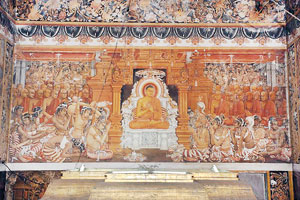Duruthu Perahera and a temple’s restoration

Mural paintings at Kelaniya Temple
“In the eighth year after he had attained to buddhahood, when the Vanquisher was dwelling in Jetavana, the Master, set forth surrounded by five hundred bhikkhus, on the second day of the beautiful month of Vesäkha, at the full moon, and when the hour of the meal was announced the Vanquisher, prince of the wise, forthwith putting on his robe and taking his alms-bowl went to the Kalyani country, the habitation of Maniakkhika. Under a canopy decked with gems, raised upon the spot where (afterwards) the Kalyanicetiya was built, he took his place, together with the brotherhood of bhikkhus, upon a precious throne-seat. And, greatly rejoicing, the naga-king with his following served celestial food, both hard and soft, to the king of truth, the Conqueror, with his followers….”
Thus the Mahavamsa records the visit of the Buddha to Kelaniya. This was the third visit of the Buddha to Sri Lanka during which he visited several other places as mentioned in the stanza recited by the Buddhists to pay homage to the ‘Solosmasthana’ – 16 holy places visited by the Buddha.
The much-venerated Raja Maha Viharaya in Kelaniya dating back to the days of the ancient kings becomes the centre of attraction when the annual Duruthu Perahera is held over three days from tomorrow, Monday January 9. The Perahera commemorates the visit of the Buddha to Kelaniya.
The Perahera was first held on the initiative of Don Walter (DW) Wijewardene, son of the great philanthropist, Helena Wijewardene, who restored the Kelaniya temple to its pristine glory in the early years of the 20th Century.A Christian turned Buddhist after her marriage to Don Philip Tudugalle Wijewardene, the wealthy lady from Sedawatte Walauwa visited the Kelaniya temple on a full moon day in 1880. Realising the Vihara was not paved when her feet sank into the mud when she walked in to offer flowers at the Buddha statue, she got the floor paved and later replaced the wooden altar with a marble altar.
The first Perahera in 1927 coincided with the laying of the foundation stone for the complete restoration of the Vihara. A new wing was added to the old shrine room with a Kandyan-style octagonal roof. While maintaining the original Kandyan era murals a new set of murals were created by master-craftsman Soliyas Mendis.
Realising the need to provide resources for the maintenance of the temple Mrs Wijewardene donated a paddy field and coconut land with an extent of 250 acres and created ‘The Kelaniya Kalawa Trust Fund’ to manage the income from them. Another land named Uyanwatta situated on the other side of the river was gifted to be maintained as a flower garden for the daily requirements of flowers for the temple poojas.
Tomorrow, being the first Buddhist religious and cultural festival for the year, devotees from all over will gather at the temple situated on the bank of the Kelani Ganga in its final lap flowing down from Sri Pada through to Colombo where it reaches the sea. According to legend, while the Naga king Maniakkhika on whose invitation the Buddha visited Kelaniya built a dagoba in the shape of a heap of paddy over the gem-studded throne offered to the Buddha, another had been built on the spot where the Buddha is believed to have kept his robes and bathed in the river.
Kelaniya has a cherished history. It was a sub-kingdom during the Anuradhapura period, ruled by King Devanampiyatissa’s brother Uttiya(3rd century BC) who had reconstructed the dagoba and the monastery.
The Polonnaruwa kings (1010-1215 AC) had continued to patronise the Kelaniya temple and King NissankaMalla after paying a visit, had arranged to renovate the temple and gifted a large extent of land for its upkeep. With the invasion by Magha of Kalinga in 1215 AC Kelaniya fell into decay until Vijayabahu III (1232-36), who ruled from Dambadeniya reconstructed the image house and the dagoba. His son, Parakramabahu II (1236-70) is credited with restoring the ‘Pasmahal Pasada’ – the five-storied building and other renovations.
The Kotte period (1412-1551) saw the temple flourishing with the kings offering patronage to the temple because of its close proximity to the capital. At a time when higher ordination was extinct in Burma (now Myanmar) during the reign of King Bhuvaneka Bahu VI (1469-77), 45 monks had been sent to Kelaniya to receive higher ordination. Veedagama Maha Thera (author of ‘Buduguna Alankaraya’) had conducted the ‘upasampada’ ceremony in the Kelani Ganga on boats hooked together, with a canopy covering them, under royal patronage.
The advent of the Portuguese in 1505 AC saw the dawn of a dark age for Buddhism. The Dutch who succeeded the Portuguese were no better. However King Kirti Sri Rajasinghe saw that the restoration work was carried out by Ven. Attadassi Thera, a pupil of Ven. Velivita Sri Saranankara Sangha Raja. Once the dagoba, the image house and the monks’ dwellings were completed the king decreed that Ven. Attadassi Thera be the incumbent of the temple.
The temple once again fell into decay when the British captured the Kandyan kingdom in 1815 and it fell on Mrs. Wijewardene to restore the Kelaniya Raja Maha Viharaya.


